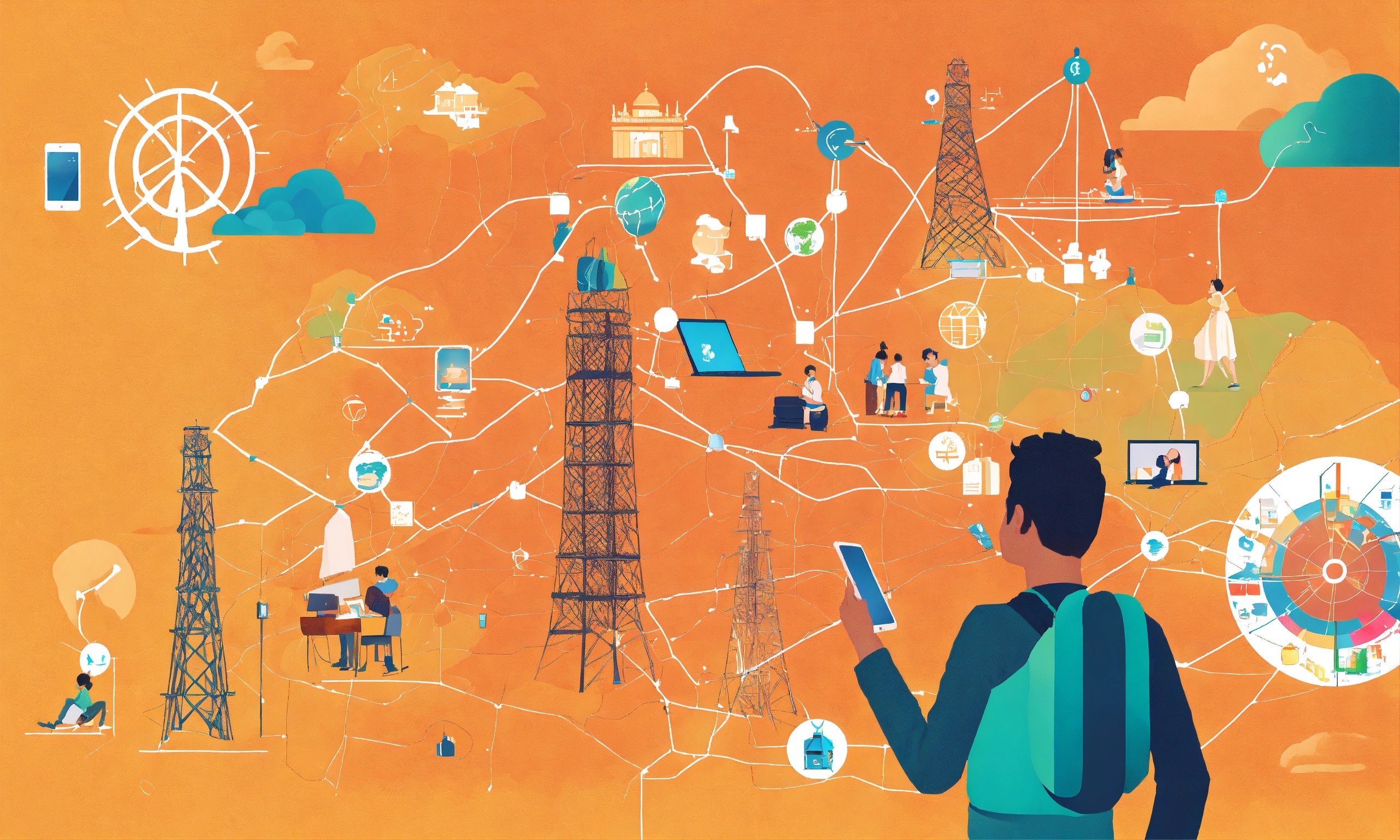Smart Cities have been greatly transformed by the evolution of mobile technology over the years. From the invention of smartphones to the integration of smart devices, the impact on urban development has been monumental. This technological revolution has not only made our daily lives more convenient but has also paved the way for sustainable and efficient urban environments. Let’s explore deeper into the journey of mobile technology and its profound effects on shaping the cities of the future.
The Dawn of Mobile Technology
The First Generation: Analog Cell Phones
On the horizon of technological progress, the first glimmers of mobile technology emerged, paving the way for a revolution in communication. The arrival of the first generation of analog cell phones marked a significant milestone in the history of telecommunications. These devices, albeit bulky and limited by today’s standards, represented a breakthrough in the ability to communicate wirelessly.
The Rise of Digital: 2G and 3G Networks
For the next phase of mobile technology, the transition to digital networks ushered in a new era of connectivity. The advent of 2G and later 3G networks brought about a significant improvement in call quality, data speeds, and expanded the possibilities for mobile communication. This shift laid the foundation for the future development of more advanced mobile technologies.
A crucial evolution during the rise of digital networks was the ability to transmit data alongside voice, enabling the usage of services like text messaging, internet browsing, and multimedia content. With increased data speeds and capacity, access to applications and services expanded, creating new opportunities and transforming the way people interacted with technology on the go.
The Smartphone Revolution
Some say that the introduction of smartphones marked a significant turning point in the way we interact with technology and each other. With the ability to access the internet, send emails, and download apps all in the palm of our hands, smartphones quickly became an indispensable part of daily life.
The Game-Changer: Apple’s iPhone
Apples entrance into the smartphone market with the iPhone in 2007 revolutionized the industry. The sleek design, user-friendly interface, and robust App Store set a new standard for what a smartphone could be. The iPhone not only changed how we communicate but also how we consume information, entertainment, and services.
Android’s Entry and the Rise of Competition
With the success of the iPhone, other companies quickly entered the smartphone market. With Googles introduction of the Android operating system, competition in the industry soared. Android offered users more choices in terms of hardware and price points, challenging Apples dominance.
For instance, Samsung emerged as a major competitor to Apple with its Galaxy series, offering a range of devices to suit different budgets and preferences. This competition fueled innovation and led to rapid advancements in smartphone technology.
The Impact on Personal and Professional Lives
Apples iPhone and the proliferation of Android devices have had a profound impact on both personal and professional lives. Smartphones have made communication more accessible and efficient, enabling people to stay connected wherever they are. The ability to access emails, calendars, and documents on the go has blurred the lines between work and personal time.
Lives have been transformed by the convenience and connectivity that smartphones provide, but concerns have also arisen about issues such as smartphone addiction and privacy. As mobile technology continues to advance, it will be crucial to strike a balance between harnessing its benefits and mitigating its drawbacks.
Mobile Internet and the Digital Divide
Despite the advancement of mobile technology, there remains a significant digital gap between those who have access to the internet through smartphones and those who do not. This discrepancy in access to mobile internet services creates a divide in opportunities for education, job access, and social connectivity.
The Shift to 4G and Beyond
To keep up with the increasing demands for data and faster internet speeds, the global shift to 4G and beyond technologies has been crucial. This transition has allowed for more efficient use of mobile networks, enabling smoother internet browsing, quicker downloads, and enhanced connectivity for users worldwide.
Global Access and the Digital Gap
Access to mobile internet services varies greatly across the globe, with developed countries enjoying widespread coverage and high-speed connections, while developing nations struggle to provide basic internet access to their populations. This digital gap perpetuates socio-economic disparities and limits opportunities for growth and development in marginalized communities.
Mobile internet connectivity has the power to bridge the gap between the developed and developing world, empowering individuals with access to information, resources, and opportunities like never before.
Mobile-Only Internet Users and the New Normal
As mobile devices become more affordable and accessible, an increasing number of individuals rely solely on their smartphones for internet access. This trend has given rise to a new demographic of mobile-only internet users who depend on mobile technology for work, socializing, entertainment, and necessary services.
Mobile-only internet users represent a growing segment of the global population, shaping the way we interact and engage with the digital world.
Internet connectivity through mobile devices is revolutionizing the way we communicate, access information, and participate in the digital economy. Bridging the digital gap and ensuring equal access to mobile internet services is necessary for creating a more inclusive and connected global society.
The Internet of Things (IoT) and Smart Devices
The Rise of Wearables and Health Monitoring
On the brink of an era where technology intertwines seamlessly with our daily lives, wearables have emerged as a prominent feature in IoT. These smart devices, adorned as trendy accessories, play a crucial role in health monitoring. From tracking heart rates to monitoring sleep patterns, wearables offer users real-time insights into their well-being.
Smart Homes and the Connected Living Space
On the horizon of technological advancements lies the concept of smart homes – a connected living space where every device communicates to create a harmonious environment. Imagine a world where your thermostat adjusts automatically based on your schedule, or your fridge orders groceries when you’re running low. These smart devices not only enhance convenience but also promote sustainability and energy efficiency.
Things are changing rapidly in the domain of smart homes. With the integration of voice assistants like Amazon’s Alexa and Google Assistant, controlling your surroundings has become as easy as uttering a command. The possibilities seem boundless as the Internet of Things continues to shape our living spaces.
IoT in Industry and Infrastructure
With the proliferation of IoT, industries are experiencing a revolution in the way they operate. From predictive maintenance in manufacturing plants to smart grids in energy distribution, IoT is optimizing processes and increasing efficiency across various sectors. These smart technologies are not only streamlining operations but also paving the way for a more sustainable and interconnected future.
Wearables, once limited to fitness trackers, are expanding their capabilities to monitor vital signs and provide early warnings for potential health issues. These innovative devices have the potential to revolutionize healthcare by enabling proactive interventions based on real-time data.
Smart Cities and Urban Planning
Many cities around the world are embracing the concept of smart cities and leveraging mobile technology to enhance urban planning. By utilizing data and technology, city planners can make informed decisions to improve efficiency, sustainability, and the overall quality of life for residents.
The Concept of Smart Cities and Urban Informatics
Planning in the context of smart cities involves integrating various technologies such as sensors, data analytics, and communication networks to collect and analyze data in real-time. This data-driven approach enables city officials to make proactive decisions to address urban challenges and optimize city operations.
Transportation Systems and Traffic Management
Transportation is a key aspect of urban planning, and smart cities are revolutionizing how people move within cities. Advanced systems monitor traffic flow, optimize public transportation routes, and provide real-time information to commuters, reducing congestion and improving overall transportation efficiency.
With the implementation of smart transportation systems, cities can decrease commuting times, lower carbon emissions, and enhance the overall mobility experience for residents and visitors alike.
Energy Efficiency and Green Infrastructure
For sustainable urban development, cities are focusing on energy efficiency and integrating green infrastructure. Smart technologies help monitor energy usage, optimize resource allocation, and promote renewable energy sources to reduce the environmental impact of urban living.
Efficiency in energy management not only leads to cost savings for cities but also contributes to a healthier and more sustainable environment for current and future generations.
Challenges and Opportunities
Cybersecurity Threats and Data Privacy
Threats: As mobile technology continues to advance, the risks associated with cybersecurity threats and data privacy become more prevalent. Smartphones and other mobile devices are susceptible to hacking, malware, and data breaches, putting sensitive information at risk. It is crucial for individuals and organizations to prioritize security measures to mitigate these threats and protect data privacy.
The Role of Mobile Technology in Disaster Response
Data: In times of disaster, mobile technology plays a crucial role in facilitating communication, coordinating relief efforts, and providing real-time updates to affected communities. Mobile apps and social media platforms enable quick dissemination of information, helping authorities and responders allocate resources efficiently and effectively.
This technology also enables individuals to seek help, connect with loved ones, and access important services during emergencies. The evolution of mobile technology has revolutionized disaster response strategies, making them more proactive and responsive to the needs of affected populations.
Inclusive Design and Accessibility in Mobile Tech
Technology: Inclusive design and accessibility are imperative considerations in the development of mobile technology. By ensuring that apps and devices are user-friendly for individuals with disabilities, developers can create a more inclusive digital experience for all users. Features such as voice commands, screen readers, and adjustable text sizes are examples of how mobile technology can be tailored to meet diverse user needs.
Mobile technology has the potential to break down barriers and create opportunities for individuals with disabilities to engage fully in the digital world. By prioritizing inclusive design principles, mobile technology can empower users of all abilities to navigate and utilize digital platforms with ease and independence.
To wrap up
As a reminder, the journey of mobile technology from smartphones to smart cities has been a fascinating evolution to witness. From the palm of our hands to the infrastructure of entire urban spaces, mobile technology has revolutionized the way we live and interact with our surroundings. As we continue down this path, it is important to consider the ethical and societal implications of such advancements to ensure a future that benefits all individuals and communities.
FAQ
Q: How has mobile technology evolved over the years?
A: Mobile technology has come a long way since the introduction of the first smartphones. From basic call and text functions to powerful computers in our pockets, smartphones have revolutionized how we communicate, work, and access information.
Q: What role does mobile technology play in shaping smart cities?
A: Mobile technology plays a key role in the development of smart cities by enabling communication between various devices and systems. Smartphones serve as a central hub, connecting IoT devices, sensors, and infrastructure to improve efficiency and sustainability.
Q: What are some potential future advancements in mobile technology?
A: The future of mobile technology holds exciting possibilities, such as enhanced AR and VR experiences, 5G connectivity for faster data speeds, and advancements in AI and machine learning. These innovations will continue to shape how we interact with the world around us.





